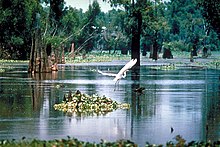Atchafalaya Basin
The Atchafalaya Basin forms the western part of the Mississippi Delta . Known as Atchafalaya Swamp , it is known as the largest swamp in the United States . The Atchafalaya River occupies a special position within the delta plain of the Mississippi because it currently, apart from the main arm, is the only estuary to build its own small growing delta.
Geographical features
The Atchafalaya Basin and the surrounding flat catchment area of the river are characterized by oxbow lakes , bald cypress trees and the marsh that absorbs the brackish water . It ends in the silt grass marsh on the coast of the Gulf of Mexico and includes the Lower Atchafalaya River, Wax Lake Outlet, Atchafalaya Bay and Atchafalaya Rivers, and the bayous Chene, Boeuf and Black.
The basin, which is always affected by severe flooding , is only sparsely populated. It is approximately 32 km wide and 240 km long. With an area of 2,410 km², it is the largest swamp wilderness in the USA and includes large areas of deciduous trees of national importance on the lower course of the river, as well as swamps, oxbow lakes and backwater lakes. The few roads run over dikes. The Interstate 10 crosses the basin on the almost 30 km long Atchafalaya Basin Bridge of Maringouin by Henderson . The Atchafalaya National Wildlife Refuge was established in 1984 to protect plant communities, endangered animal species and water and migratory birds .
Basin hydrology
The Atchafalaya Basin stretches between the current and a former main arm of the Mississippi, today's Bayou Teche. The Atchafalaya has been directing water from the Mississippi to the sea since around 1500. Since the path over the Atchafalaya to the coast is shorter and therefore steeper than the path over the eastern route, which the main arm takes, the water flow into the Atchafalaya has increased steadily since then. This process was compounded by the removal of driftwood barriers and dredging in the 19th century. Only with the completion of the Old River Control Structure , a system of dams and weirs, was this process (for the time being) stopped. Today a maximum of 30% of the water of the Mississippi is allowed to flow into the Gulf of Mexico via the Atchafalaya River.
The marsh and the excess river water
How to tame the floods along the Mississippi has become a controversial issue in recent decades. It is now believed that the river's sewer systems and the decreasing silting rate of the surrounding salt marshes are related to the increasing agricultural use of the Bayou Country area by the growing population. The United States Geological Survey reports that over 75 km² of land is lost to the sea each year.
Due to the decrease in the silting rate and the decreasing water movement, the containment of the oxbow lakes and the creation of locks by the US Army Corps of Engineers became necessary. The construction of a levee along the Atchafalaya Basin helped isolate the swamp from the river, halting the uptake of excess water by the neighboring wetlands. This reduced the oxygen uptake of the river water, which changed the color of the water from brown to black.
The littoral salt marshes form a buffer zone that protects the entire coast of Louisiana from the effects of the hurricanes in the Gulf of Mexico and dissipates the accompanying storm surges . The marsh is created by backfilling with settled silt , which now settles over the sharp edge of the continental shelf into the artificially channeled Mississippi river. From the 1950s to the 1970s, the oil industry dredged deep canals in the march in order to be able to move barges as platforms. The sharp edge continued to crumble and wide, flat channels formed in the salt marshes.
literature
The disappearance of the Delta Land is viewed by many environmental activists as one of the most significant environmental threats in the United States. The loss of the delta was discussed by author Mike Tidwell in his 2003 book Bayou Farewell: The Rich Life and Tragic Death of Louisiana's Cajun Coast (Pantheon Books, March 2003).
Web links
- Atchafalaya National Heritage Area (English)
- National Weather Service: Atchafalaya Basin (English)
- Stories and photos of the Atchafalaya Basin (English)
Individual evidence
- ^ A b Michael D. Blum, Harry H. Roberts: The Mississippi Delta Region: Past, Present, and Future. Annual Review of Earth and Planetary Sciences. Vol. 40, 2012, pp. 655-683, doi : 10.1146 / annurev-earth-042711-105248
- ^ A b Harry H. Roberts: Dynamic Changes of the Holocene Mississippi River Delta Plain: The Delta Cycle. Journal of Coastal Research. Vol. 13, No. 3, 1997, pp. 605-627
- ↑ http://www.peacecorpswriters.org/pages/2003/0303/303rvbayou.html

